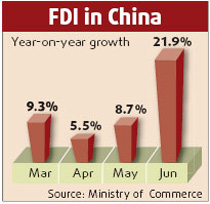Online retailing in China is set to take a big leap this year to take advantage of strong consumer confidence - but players have been warned there will be intense competition.
While benefiting from a direct sales channel and low marketing expenses, emerging online retailers will go head-to-head against existing e-commerce firms, an IT research firm said.
Beijing-based Analysys International said more than half of the comprehensive business-to-consumer (B2C) websites, which sell a variety of products, could become unprofitable as they risked losing market share to B2C sites which focus on more specific product categories.
Among the newcomers could be manufacturers of underwear, leather products, communication devices and automobiles, said Beijing-based Analysys International.
"It started from the second half of 2007, when the success of PPG resulted in others copying its model," said Cao Fei, an analyst with Analysys.
PPG, a newly emerged star selling male shirts in China, is now widely imitated for it has so far successfully carried out Dell Inc's direct sale model in shirt retailing by serving as a direct link between consumers and manufacturers.
Founded in 2005, the Shanghai-based company, with no manufacturing facility of its own, now sells about 10,000 shirts every day, challenging the nation's No. 1 shirt maker, Youngor Group Co Ltd.
Its success has inspired traditional clothing makers to go online and explore catalogue shopping methods, as they already have the branding recognition and loyal customers and don't have to spend much on advertising, as PPG did.
By moving online into direct sales they are able to make sales ahead of manufacturing, and better plan their production based on firm orders and reduce costs such as warehousing to eventually reduce the retail price.
"The concept that B2C websites should be like online department stores is being abandoned," said the Internet Society of China in a report released on Tuesday.
"Those that focus on a certain sector are gaining on popularity, but it will also result in intensified competition between the B2C websites."
There are already about 30 websites selling shirts, including traditional garment markers, and Dangdang.com, China's largest comprehensive retailer, which added shirts to its online catalogue in October.
"The vertical B2C sites have a clearer positioning, and they know who their customers are," said ChinaVenture Investment Consulting Ltd in an e-commerce industry report. "They may be smaller, but they are more focused, and it's easier for them to become leaders in their specific sectors and make a profit."
Meanwhile, Dangdang and its closest rival Joyo.com, the Chinese operation of Amazon.com, are dragged by costs of warehousing and delivery and are fighting to make ends met, according to ChinaVenture.
Combined shares of the two companies, both based in Beijing, are less than 15 percent of China's B2C market. The rest are dominated by the vertical B2C websites, including some manufacturers that already set up their own online channels in sectors such as canned foods and pharmaceuticals.
"The vertical B2C websites are doing better than the comprehensive ones, and they will become the most attractive type of business in e-commerce to investors," said ChinaVenture, citing maternity and baby products, home furnishing and jewelry as well sought-after sectors by capital.
The B2C websites posted a combined revenue of 5.22 billion yuan (US$696 million) last year, an increase of 33.5 percent over 2006, and ISC expected the annual growth rate to accelerate a little to 35.8 percent this year and 39.1 percent in 2009.
The growth comes as China's e-commerce infrastructure gets better with more and safer Internet or phone-based payment tools and the major e-commerce firms such as Dangdang and Joyo offering good compensation policies and spending more to improve their logistic service.
Average monthly spending on online shopping was 109.20 yuan last year among the 182 million netizens, ranking No. 1 among all their expenditure on Internet-based services last year, ISC's survey of 50,786 mainland Web users found.
"The traditional manufacturers are still faced with challenges such as how to operate the online direct sale and balance the conflicts with their offline channels," said Cao of Analysys. "It takes time."
(Shanghai Daily January 11, 2008)


